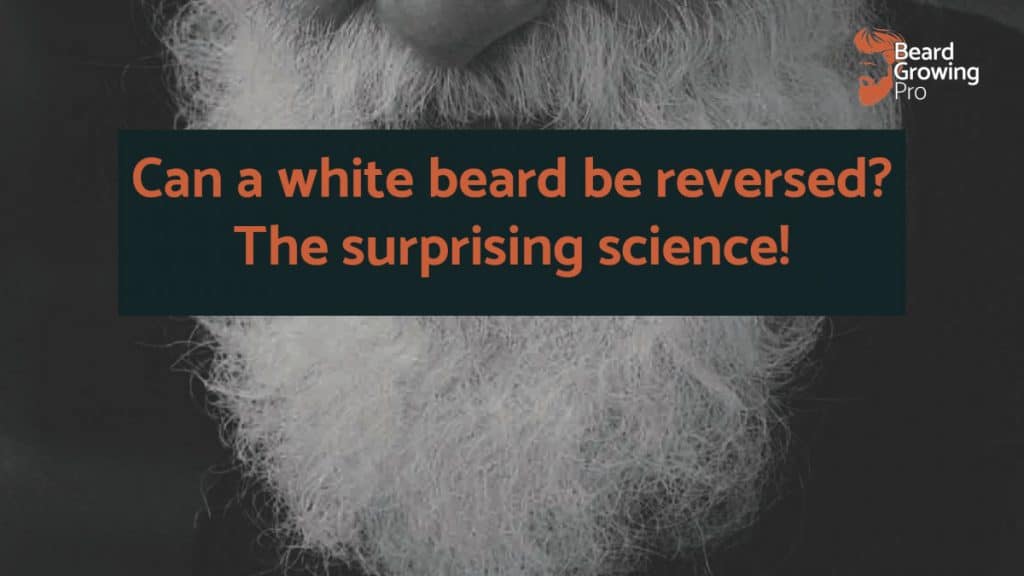Greying and whitening of the hair is considered a natural part of ageing. I have started to see grey hairs in my beard at the age of about 35. They are getting more and more as time goes on and this is a familiar trait for many bearded men. Interestingly, the actual underlying reason of why hair turns white or grey in humans is poorly understood. We have done a lot of research on animals that shows that psychological stress can cause hair to start greying and that the stress accelerates human biological ageing but it has not been explicitly linked to humans developing grey hair due to stress. In this article, we are going to uncover the scientific facts about whether or not going grey can be reversed and what that means for the white hairs in your beard.
White beard hairs can be reversed under certain circumstances. Recently, researchers from Columbia University have found that individual hairs that have recently turned grey can turn back to their original color.
This is due to hormonal changes which affect the metabolic pathways which form proteins in the body. If you reduce the stimulus causing the hormonal changes – like stress – you can reverse the color change. However, if your beard turns white because of other issues it is unlikely to be able to be reversed.
The scientists plucked hairs from volunteers and created a brand-new technique which allowed them to detect the pigment throughout the entire shaft of a hair. They were able to track the change in colour because each centimetre of hair growth accounted for about a month in time.
By analysing the hairs, they were able to have a look at the amount of colour creating protein – called melanin – in different parts of the hair.

They expected to see the hairs start to grey at the base as the hairs grow out from the scalp. However, from the nearly 400 hairs they found that the opposite was true. That some hairs were grey at the tip but coloured at the base – this was surprising and confusing as it flies in the face of what is currently understood about hair going grey.
The scientists were able to look back at the history of the volunteers stress levels and were able to find that the grey periods matched up with increased levels of stress and once the stress was alleviated the hair turned from grey back to its natural dark colour.
In future research they are hoping to reverse age related greying of hairs through drugs and other medication. This is because it shows that there is a plausible biological basis for reversing the greying of hair which could be targeted pharmaceutically.
Other science for reversing white hairs
There are also some other scientific research papers that show that hair can be turned back into its original colour after the going grey. Some of these are animal studies and others are human patients who were undergoing cancer treatment.
Firstly there was a study in 2018 that showed that the amount of melanin in the hair of adult black coated dogs was able to be increased by increasing the amount of tyrosine in their food. Clearly, this research has to be taken with a grain of salt in terms of its application to humans but it’s an interesting observation from these scientists.
As part of the study the scientists looked at two groups of adult black Labrador retriever is with 12 dogs per group. They gave the dogs different amounts of tyrosine for 24 weeks and used a fancy microscope to check the dog’s hair colour every eight weeks. The higher the intake of the tyrosine the higher the level of melanin in the dog’s coat.
In other research a group of cancer patients had their grey hair unexpectedly turn darker after they took a new type of cancer drug.
When you think about chemotherapy you think about hair falling out and perpetual sickness but 14 people in this study were being treated with a new type of drug that works differently and have significantly fewer side effects than chemotherapy.
A Spanish study from 2017 showed that 14 people among 52 patients with lung cancer showed a significant colour change in their grey hair while undergoing experiments for side effects of the drugs Keytruda, Opdivo and Tecentriq.
Most patients didn’t in fact end up with the colour change but in 14 patients their hair turned from grey to a darkish brown or black. Interestingly, the drug worked more effectively in these 14 patients which could be used as a visual sign that the drugs are working in the future.
These drugs are not safe to be used as hair darkening agents, but it does tell us that there is a biological pathway through which we can use pharmaceuticals to influence the colour of greying hair. The pharmaceutical industry has also used unexpected drug side-effects to combat male pattern baldness using combinations of drugs which were being tested for compatibility or for a combination of unrelated issues.
Science and medicine are slowly working towards combating some of our most annoying and damaging ailments and it may not be too long before a pharmaceutical solution for grey hair is developed and sold commercially.
For those of you who are not willing to wait for a pharmaceutical solution for grey beard hairs there are some other options for you in which white or grey beard hair can be reversed by using products that dye the beard hair.
What causes beards to turn white?
here are many causes of a beard going grey. It is likely that your beard is grey and simply because of the combination of your age and your genetics. However, the greying can be accelerated by things like smoking and not eating enough antioxidants so that oxidative stress ages your beard hair quicker.
Here is a quick rundown on the things that make your beard go grey.
Genetics
I’m afraid to say that genes are the biggest cause of you turning grey. A 2016 study highlighted the first ever gene that the researchers were able to associate with greying.
Head hair and beard hair go grey for the same reason. Hair contains cells called melanocytes which are pigments that create colour in the hair (eumelanin =black and brown, pheomelanin = yellow and red). It’s the eyelashes that contain the most of these pigmented cells and that is why they are a little darker than most on your head.
As time goes on, the pigment cells start to dye away. They are normally replenished by stem cells at the bottom of the hair root – but that process simply stops working.
Age
Your beard is constantly regenerating. As hairs fall out new hairs grow in their place. Hair grows in three stages and the cycle repeats over and over again until the hair follicle is no longer able to create hair.
As you get older your beard hair follicles are less able to create the pigment cells which get incorporated into the hair as it grows. The age at which your pigment cells no longer effectively make hair changes from person to person. I know of some people who started having their first grey hairs in their 20s and some 70-year-olds who never lost their dark hair.
Oxidative stress
Oxidative stress can prematurely accelerate the presence of greying in your beard. Free radicals are unstable molecules that are formed in the body through normal metabolic processes or UV rays. Your body is quite effective at mopping up these reactive molecules however you can give it a boost by eating a load of different healthy foods. These include:
- blueberries
- dark chocolate
- strawberries
- raspberries
- spinach
- beetroot
- Kale
- carrots and other orange vegetables
- artichokes
- and more…
As long as you are eating a balanced and complete diet you will be able to easily ward off the effects of oxidative stress on your beard.
Smoking
A study published in 2013, looked into smokers hair and investigated the question: does smoking cause premature hair greying?

This study was conducted in a non-clinical setting and included 207 participants. The participants were classified into two groups which were premature hair graying and normal hair graying stop premature hair greying was defined for the case of this study as the appearance of grey hair before the age of 30.
The study found that there was a significant relationship between the onset of grey hair before the age of 30 (premature greying) and smoking cigarettes. The prevalence of smokers in the premature hair greying group was higher at 40.2% versus 24.7% for normal hair greying. By using some complicated mathematics smokers were found to be 2 ½ times more prone to develop premature hair greying.
I think based on this study we can confidently say that if you are a smoker you are much more likely to end up with premature grey beard hair!
White hair in beard solutions
If you have white hair in your beard and you want to cover it up the only real solution for the majority of men is to use a dying or darkening product.
Dying
Using a beard dye is completely acceptable and in recent years the formulations have got so good that many people cannot tell the difference between a died beard and a naturally dark beard. If you want to know more about if it’s okay to dye your beard check out my other article – is it okay to dye your beard? Busting the myths – click here to be taken to article.
There are a number of awesome formulations on the market which will leave your beard looking natural whilst also being very easy-to-use.
Grey beard reversing oil
There is a beard darkening oil on the market which combines an exotic blend of natural herbs to darken your beard.
It contains a combination of dark naturally occurring dies which enable you to cover up the premature greying of your beard. All you have to do is take a few drops of the oil and massage into your beard for about two minutes. Then you should leave it in overnight or for at least one hour before washing your beard.
There are many positive results and reviews online for this product and many people find that to get good results you need to wait for a significant amount of time but if you are patient you will get good results.
Temporary Beard Color Stick
Temporarily beard sticks are like lipstick for your beard. It is portable and easily fits into your pocket and can change the colour of your beard in seconds. It is not a permanent dye and can be used for your moustache, beard, and side burns. This is perfect if you have the one or two grey hairs that you want to cover up quickly and it can easily be washed out with soap and shampoo.
You can use a locking spray to make the product darker and to stop it from transferring to your skin and clothes. Like the other options in this temporary Beard dye section if you touch your face a lot you should consider using a semipermanent beard dying solution otherwise it can easily end up on your hands and clothes.
Frequently asked questions
At what age beard becomes white
In a study published in 2012, the prevalence of grey hairs on the body was: 51.5% of people had grey hair in their 30s, 81.18% of respondents had grey hair in their 40s, and 95.3% of people had grey hair in their 50s. Therefore, you are about 50% likely to get grey hairs in your 30s which increases significantly as you enter your 40s and beyond.
The study looked at a total of 522 men and 480 women recruited between the ages of 12 and 91 years old. Clearly, this doesn’t specifically look at beard hair is going grey, but I think it is still a good indication of the age that you can expect to find grey beard hairs.
How do I get rid of white beard permanently?
The only way to get rid of white beard permanently is to use a permanent removal solution as the hair follicle will always produce grey hairs once it has gotten older and started to produce white hairs.
There are a number of ways to permanently remove individual hairs this includes:
- electrolysis – electrolysis is a method of removing hairs which destroys the growth centre of the hair with chemical or heat energy. A fine metallic probe is normally inserted into the hair follicle and the hair is removed by tweezers. This enables you to individually remove grey hairs that sit in your beard. For it to be effective you typically have to remove the hair between eight and 12 times for it to be permanently removed.
- Plucking or waxing – if you keep on removing the hairs produced by the same hair follicles they will eventually become fewer in number and the hair follicle will stop producing as many hairs.
Plucking the hairs as they turn white might thin out your beard to the point where it would actually be better to let it turn grey or white rather than continuously pluck away the hairs.
How do you get rid of white beard hair naturally?
There are a number of ways to naturally darken your beard and if you want to find out my full recipe list check out my other article – how can I naturally darken my beard? – Click here to check out article in full…
Here are some of my favourites from that article:
- Henna – down your beard with henna is a relatively simple process. All you have to do is buy the powder and mix it with water until it forms a paste. You can then smear into your beard making sure not to get on anything else because it will stain anything that it comes into contact with.
- Black walnuts – just like the henna powder all you have to do is crush up the black walnuts and add water until it forms a paste which will sit in your beard without dripping. Allow to sit for one hour before applying to your beard for the colour to fully develop. You may want to add heat to your hair as it may increase the amount of colour that it takes up.
There are many other options for getting rid of white beard hair naturally in the article – should definitely check it out.
Conclusion
The science is slowly working towards reversing a white beard. It will be a few years yet before we see any pharmaceutical intervention but, in the meantime, you can use a variety of techniques including removing individual grey hairs as you see them with either electrolysis or plucking or dying beards with a good quality natural ingredient hair dye or with a temporary solution like a beard colour stick.
There comes a point in everyone’s beard growing journey where you should just embrace your natural beard colour no matter what it is even if that is white. Confidence with a beard comes from looking confident with any beard that you can grow!
Happy beard growing!



